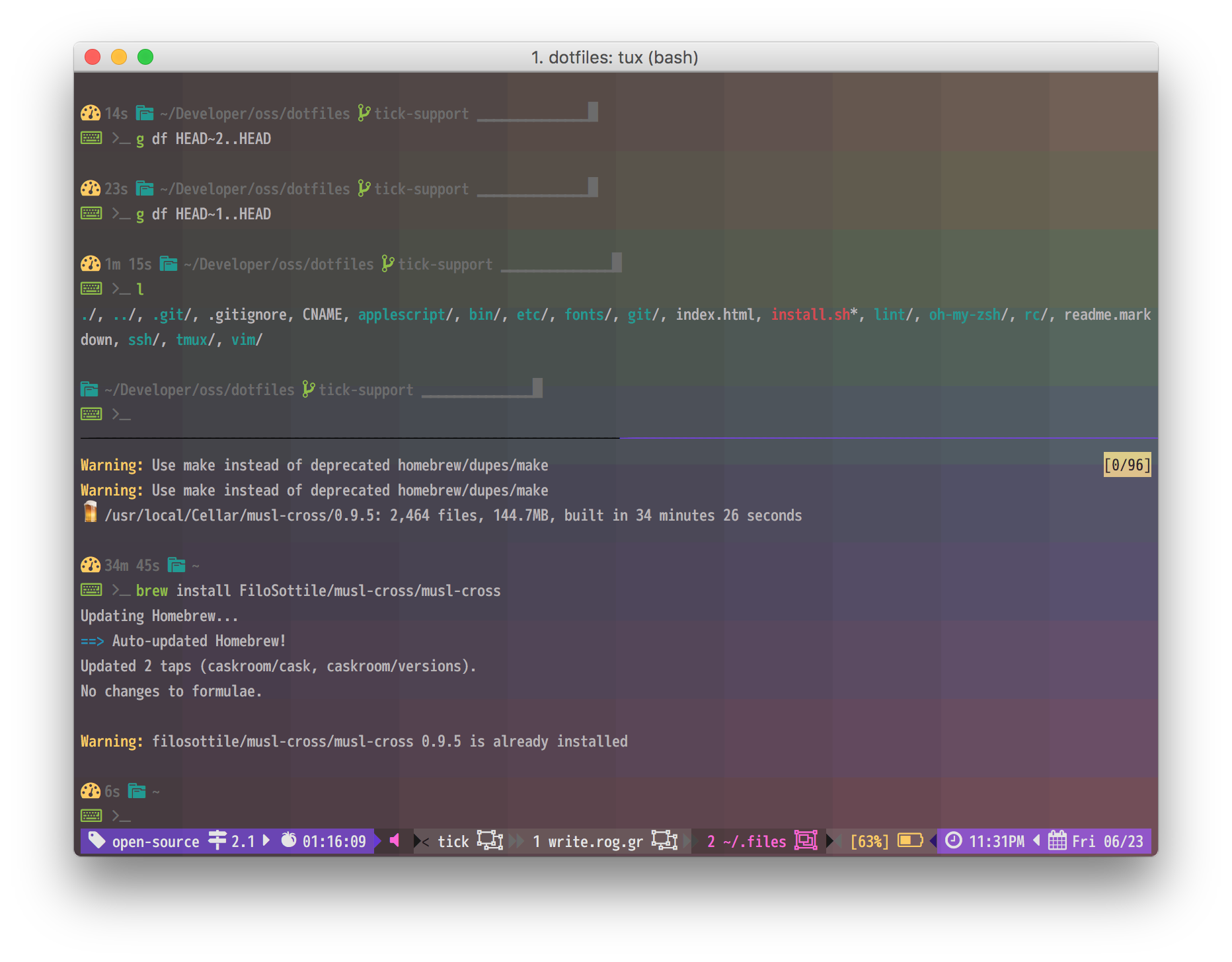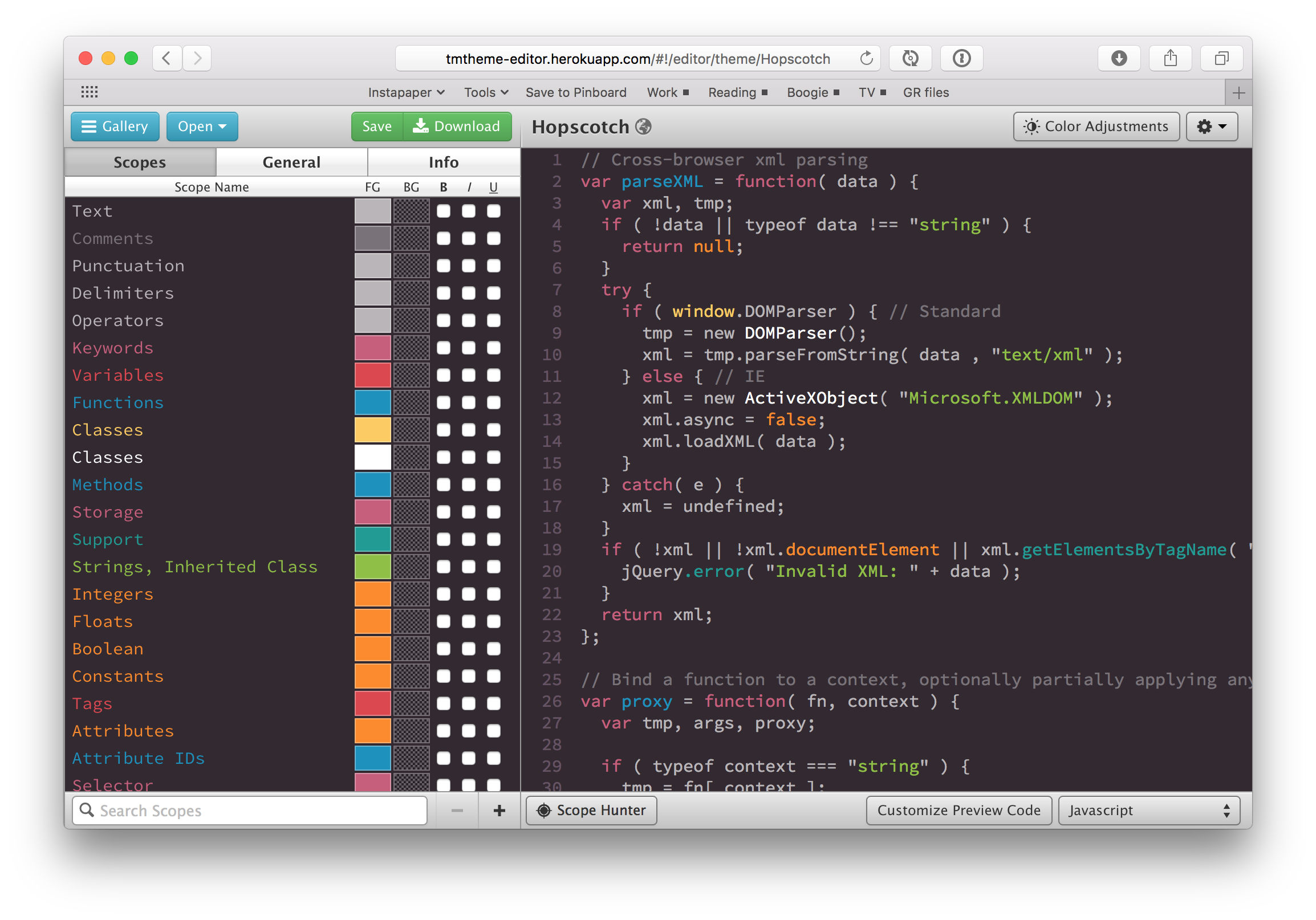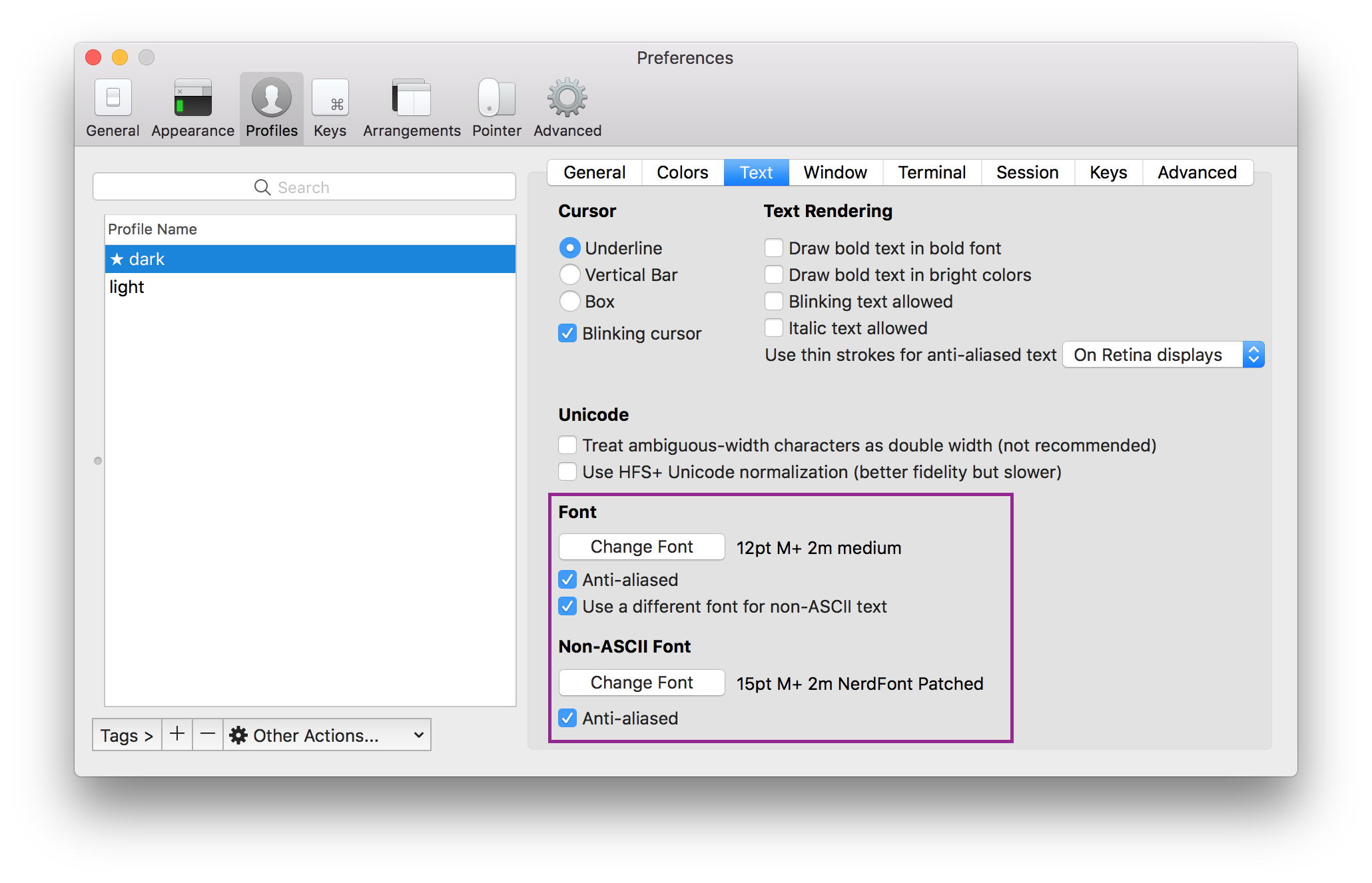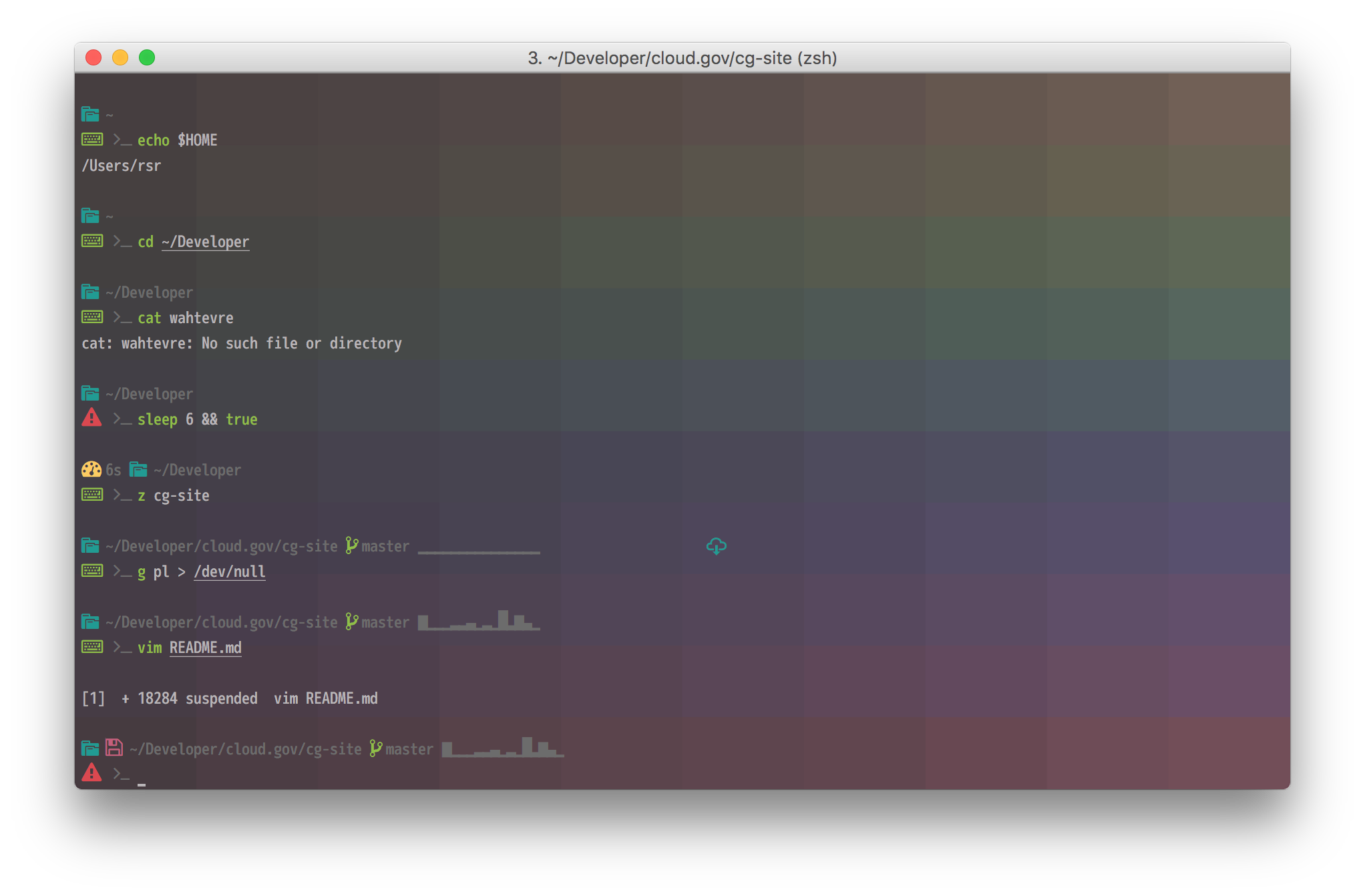Smooth terminal
Table of contents
Getting started
This guide is more of a review of the decisions that went into my
Prompt String 1(PS1). Your mileage may vary, but remember to have fun and create the PS1 you want to see in the world.
> Skip ahead
I really really really spend a lot of time in a terminal. I got hooked all the way back in my MS-DOS days with the idea that I could write a set of instructions and have the machine act them out repeatedly for me. The fact that so much can be automated in a shell with an incredibly small amount of code is one of my favorite aspects of using it. There’s also the added benefit of intent, or friction depending on what you’re doing, that using only a keyboard facilitates when working in high-risk environments. Mice and touch are nice modernities of contemporary computer life, but it’s nice to feel like you’re back in the 80s and 90s logged into a computer somewhere else. It’s also really great to seamlessly continue working the same way you’re used to working when you have to context-switch onto another machine.
I’m going to walk you through my terminal setup and how it came to fruition. It’s
something I modify consistently whenever I introduce a new workflow or metric
into what I do every day. Sometimes they’re cosmetic like adding font
icons
everywhere and other times they’re foundational like when
I wrote a time-tracking tool
to move away from a NodeJS
implementation because I thought it was too slow for my taste.
Use a framework, so you don’t have to think of everything
I use oh-my-zsh
because it’s dope. But there are other
frameworks
out there for other shells
as well. The idea
here is for the shell framework to help you not have to think about some basic
things that can get displayed on the PS1 prompt. It’s also super common for
shell frameworks to come with themes that you can leverage instead of
customizing the PS1 completely on your own. This is important because the PS1
prompt can be really difficult to modify and can cause you to give up. You
should take all the help in the world and find a good thing that
works for you to put in your terminal after you tweak it a bit. I believe in you.
Pick a good theme, scheme, and font
PS1 theme
The theme I use is real
, a modified version of pure
,
for ZSH. I really like how pure is simple and fast. I modified it to go against
everything that pure stands for and cluttered the ever-living pixels out of my
PS1 using my own custom font. I’m a visual person and I like having little
iconography everywhere I go especially since I never leave the terminal.
Color scheme
This part was really important for me. I use Hopscotch
. It’s
a color scheme based on an iOS app
which is for teaching kids
how to code. I chose it because I wanted to remind myself that I want to teach
my children how to code. It’s also purple and I love the color purple. And if
my kids ultimately decide that programming isn’t a thing they’re interested in
then at least I have my purple color scheme and it’s the thought that counts
anyway.

I have switched between light and dark styles, but eventually settled on just using dark styles to make things less complicated. It’s still bright, but it does discourage me to work in direct sunlight. If you’re outside in the sun with a computer it shouldn’t be to work on it, but to treat it like today’s NYC 1980s boombox. Put that thing on your shoulder and drop the beat.
There’s this great Textmate Theme Editor
that you can use to
inform which theme you’d like to chose. You can also download the file there and
use them in a lot of popular editors or use it as a foundation to edit the
source of a theme for your favorite text editor.

Font
I like the open-source M+ font
a lot because of how much the lowercase
g in the M+ M Type-2 family looks like my hand-written lowercase g.
gggggggggggggggggggggggggggggggggggg
it's a really nice g, isn't it?It’s also open-source. I like the fact that I can store the compiled font
somewhere
and not worry about losing access to the font or
worry about licensing. I also use the font on my site for all my code excerpts
on this site. I think it looks great.
Working with NerdFonts Patcher
Once I discovered the NerdFonts patcher
, I immediately patched my
own M+ 2m font to use in iTerm. iTerms supports two different fonts for ASCII
and non-ASCII text so those icons will look great next to your favorite font.

I used this and ran all the bits. It was a load of work, so maybe just pick something that’s already patched. I didn’t. I didn’t because the particular font family I use wasn’t officially supported. I’m very particular so I patched a version of the font I use and modified iTerm to leverage both fonts depending on what it was rendering. It’s great since I can set the width of the characters separately for each font.
Treat your PS1 like Jon Ivy treats the Touch Bar
I like to make sure I have as much information on display at any given time. It’s a good place to let out your creative side out and it helps to understand typographic emphasis. And with my patched version of my favorite font with icons, I customized every last pixel on my PS1 prompt.

Below are some excerpts from my modified pure theme, real.
prompt_pure_job_count() {
local job_count=$(jobs | wc -l | xargs)
if (( $job_count > 0 ))
then
echo -n " "
fi
}I like to know if I have any background jobs running without having to run
jobs. What better way to represent that than with an old floppy disk. Remember
that feeling of having a floppy in disk in your computer and hearing that
rattling sound when the computer was reading from it? This function brings me
back to those days.
prompt_pure_git_diary() {
command git rev-parse --is-inside-work-tree &>/dev/null || return
command git log -1 &>/dev/null || return
for day in $(seq 14 -1 0); do
git log --before="${day} days" --after="$[${day}+1] days" --format=oneline |
wc -l
done | spark
}I like to keep diaries even if they’re absurd or visual. Git keeps a really good record of activity so I figured, why not show what the activity for a particular branch is using spark charts.
prompt_pure_precmd() {
# ... shortened for brevity
local prompt_pure_preprompt='\n%F{yellow}`prompt_pure_cmd_exec_time`%f%F{cyan} %F{magenta}`prompt_pure_job_count`%F{242}%~ $vcs_info_msg_0_ %F{242}`prompt_pure_git_diary`%f %F{yellow}`prompt_pure_git_dirty`%f $prompt_pure_username %f'
print -P $prompt_pure_preprompt
# check async if there is anything to pull
(( ${PURE_GIT_PULL:-1} )) && {
# check if we're in a git repo
command git rev-parse --is-inside-work-tree &>/dev/null &&
# check check if there is anything to pull
command git fetch &>/dev/null &&
# check if there is an upstream configured for this branch
command git rev-parse --abbrev-ref @'{u}' &>/dev/null &&
(( $(command git rev-list --right-only --count HEAD...@'{u}' 2>/dev/null) > 0 )) &&
# some crazy ansi magic to inject the symbol into the previous line
print -Pn "\e7\e[A\e[1G\e[`prompt_pure_string_length $prompt_pure_preprompt`C%F{cyan}%f\e8"
} &!
}The precmd function here is what prints out the little manilla folder and
cloud icons when there are remote changes in a git repository.
prompt_pure_setup() {
# ... shortened for brevity
zstyle ':vcs_info:*' enable git
zstyle ':vcs_info:git*' formats "%F{green}%F{242} %b"
zstyle ':vcs_info:git*' actionformats "%F{green}%F{242} %b %F{green} %F{242} %a"
# prompt turns red if the previous command didn't exit with 0
prompt_okay="%F{green} "
prompt_not_okay="%F{red} "
PROMPT='%(?.${prompt_okay}.${prompt_not_okay})%f %F{242} %f '
}Here I output some git related icons, and okay / not_okay iconography based on the exit status of the last command than ran.
tl;dr
I hope you enjoyed reading this and that it helps inspire you to modify your command prompt. Take your tools seriously and take the time to customize them. It’s very difficult to try and keep all the context in your head when something as highly conceptual as a terminal. Iconography and specific output can be super helpful when working in a terminal, so take the time to add what you want to know your PS1 prompt. At the bare-minimum, you should be able to look at your PS1 prompt and know where you are, what you’re doing, and possibly what just happened.
This post was written by a human & not by artificial intelligence (AI) tools. I’m not stating anything against AI here but I am interested in differenciating content created by people versus machines. To find out more about the Not by AI badge, please click it.
If you enjoyed this post, please explore other posts by the topics listed below.
Iterating again and again